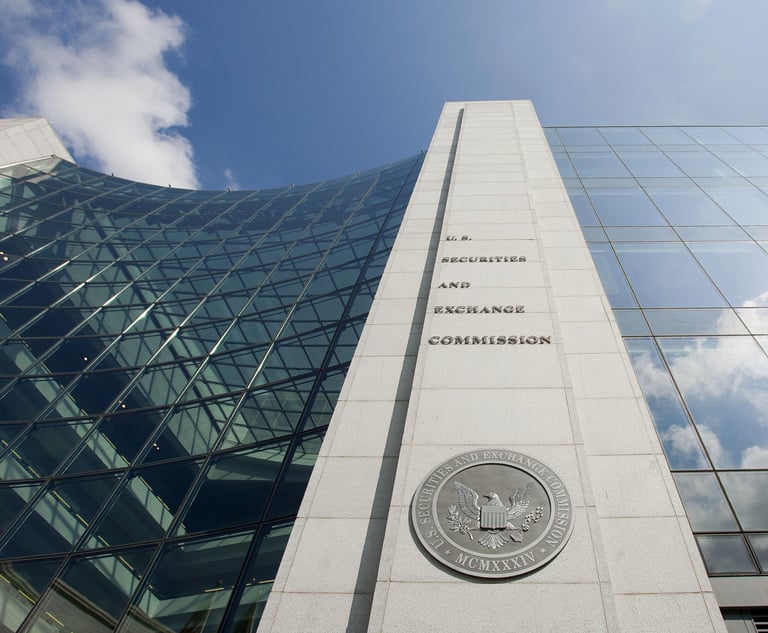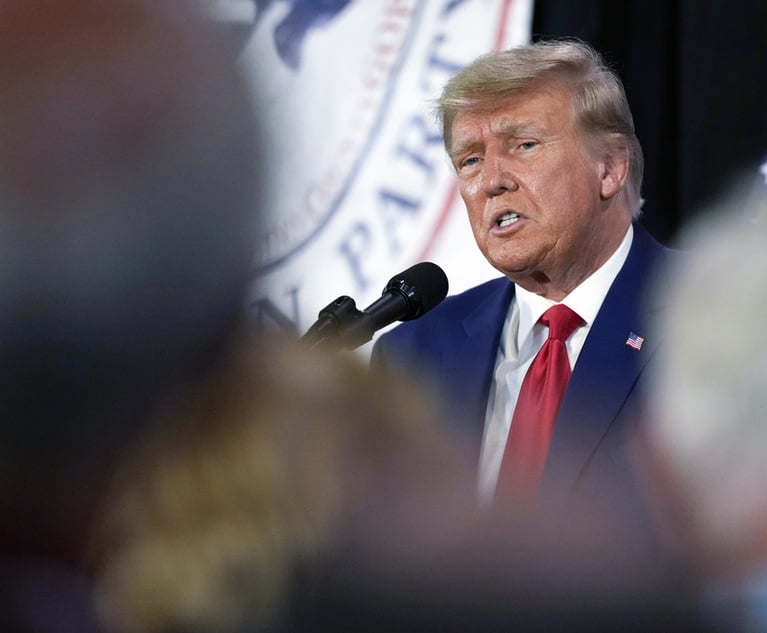New Intellectual Property Metric Helps Manage & Measure Risk
Today, metrics have become essential to the business and practice of law. A new one, with the potential to help anyone involved in intellectual property…
July 31, 2017 at 01:00 PM
4 minute read
The original version of this story was published on Law.com
Today, metrics have become essential to the business and practice of law. A new one, with the potential to help anyone involved in intellectual property litigation, has evolved called the Litigation Year or Lit Year. Developed by Bryan Wheelock a lawyer with IP law firm Harness Dickey, the “Lit Year” is the cost of one year of IP litigation. The Lit Year benchmark can provide perspective when considering whether an activity is worthwhile.
Recent reports have the median cost of a medium patent infringement case at $2 million and the time to trial at 2.4 years. This puts the Lit Year at a cost of $833,000. For example, a $350,000 IPR might initially sound budget busting, but if you consider that it is only 0.42 lit years — the amount you would spend in about five months of litigation — it starts to make sense.
Wheelock sat down with Inside Counsel to discuss how the Lit Year can help manage and measure risk, or more precisely the cost of reducing risk and can be applied to specific intellectual property situations since the cost of litigation varies based upon subject matter and location.
So, how did Wheelock come up with this idea?
“While watching a recent episode of Jeopardy, a contestant did not understand that a 'light year' was a measure of distance, not time. It got me thinking about what a convenient unit of measure the light year was to bring understanding to astronomically (literally) large numbers,” he explained. “This brought to mind litigation costs, which are the only astronomical (figuratively) numbers in IP law. And I thought the amount of money spent in a year of IP litigation – the 'Lit Year' – was an interesting unit of measure to bring understanding to IP litigation costs.”
These days, metrics have become essential because they provide a basis to evaluate and select among various courses of conduct. As long as metrics are used properly, they can make decision-making more objective and less personal. However, when not understood, metrics may support or even encourage bad decision-making. The Lit Year is a way to bring perspective to the cost of conducting or not conducting an activity.
The high cost of IP litigation is well known, but comparing the cost of a course of conduct against the typical cost of a patent infringement lawsuit is not logical. First, a lawsuit may not ever be brought. Second, even if a lawsuit was brought, it is unlikely to proceed all the way to a jury trial and appeal to the Federal Circuit – only five to 10 percent of cases ever make it all the way through trial. Instead, according to Wheelock, evaluating the cost of a course of conduct relative to how long it would take to spend the equivalent amount in litigation gives a basis to compare the costs.
The Lit Year is a simple double-check on decisions. – it may help make better decisions, or add a level of confidence to decisions that have been made, and in this respect may save some time and money, according to Wheelock. It is just another way to look at and evaluate various courses of conduct.
“Consider the light year – it's one thing to say that something is six trillion miles away, but when you frame that distance as the distance light could travel in year, one has greater perspective than just a stark measure of distance. So, too, with the Lit Year,” he explained.
In fact, the most recently published AIPLA Economic Survey reports the median cost of a medium ($2-$10 million) patent infringement case at $2 million. The 2017 PWC Litigation Study puts the median time to trial in a patent case at 2.4 years. This makes a conservative estimate of the Lit Year at a little over $833,000.
“Consider a company trying to decide whether to bring a $350,000 IPR to challenge a patent asserted against them. This might initially sound budget busting, but if you consider that it is only 0.42 lit years — the amount you would spend in about 5 months of litigation — it might make sense,” Wheelock explained. “ Similarly, a company deciding whether a $20,000 new product clearance is a necessary expense should consider that that this is just 0.024 lit years — the amount they would spend in about six days of litigation, it may sound like a better idea.”
This content has been archived. It is available through our partners, LexisNexis® and Bloomberg Law.
To view this content, please continue to their sites.
Not a Lexis Subscriber?
Subscribe Now
Not a Bloomberg Law Subscriber?
Subscribe Now
NOT FOR REPRINT
© 2024 ALM Global, LLC, All Rights Reserved. Request academic re-use from www.copyright.com. All other uses, submit a request to [email protected]. For more information visit Asset & Logo Licensing.
You Might Like
View All
SEC Penalizes Wells Fargo, LPL Financial $900,000 Each for Inaccurate Trading Data

US Reviewer of Foreign Transactions Sees More Political, Policy Influence, Say Observers

Pre-Internet High Court Ruling Hobbling Efforts to Keep Tech Giants from Using Below-Cost Pricing to Bury Rivals
6 minute read
Preparing for 2025: Anticipated Policy Changes Affecting U.S. Businesses Under the Trump Administration
Trending Stories
- 1Arnold & Porter Matches Market Year-End Bonus, Requires Billable Threshold for Special Bonuses
- 2Advising 'Capital-Intensive Spaces' Fuels Corporate Practice Growth For Haynes and Boone
- 3Big Law’s Year—as Told in Commentaries
- 4Pa. Hospital Agrees to $16M Settlement Following High Schooler's Improper Discharge
- 5Connecticut Movers: Year-End Promotions, Hires and an Office Opening
Who Got The Work
Michael G. Bongiorno, Andrew Scott Dulberg and Elizabeth E. Driscoll from Wilmer Cutler Pickering Hale and Dorr have stepped in to represent Symbotic Inc., an A.I.-enabled technology platform that focuses on increasing supply chain efficiency, and other defendants in a pending shareholder derivative lawsuit. The case, filed Oct. 2 in Massachusetts District Court by the Brown Law Firm on behalf of Stephen Austen, accuses certain officers and directors of misleading investors in regard to Symbotic's potential for margin growth by failing to disclose that the company was not equipped to timely deploy its systems or manage expenses through project delays. The case, assigned to U.S. District Judge Nathaniel M. Gorton, is 1:24-cv-12522, Austen v. Cohen et al.
Who Got The Work
Edmund Polubinski and Marie Killmond of Davis Polk & Wardwell have entered appearances for data platform software development company MongoDB and other defendants in a pending shareholder derivative lawsuit. The action, filed Oct. 7 in New York Southern District Court by the Brown Law Firm, accuses the company's directors and/or officers of falsely expressing confidence in the company’s restructuring of its sales incentive plan and downplaying the severity of decreases in its upfront commitments. The case is 1:24-cv-07594, Roy v. Ittycheria et al.
Who Got The Work
Amy O. Bruchs and Kurt F. Ellison of Michael Best & Friedrich have entered appearances for Epic Systems Corp. in a pending employment discrimination lawsuit. The suit was filed Sept. 7 in Wisconsin Western District Court by Levine Eisberner LLC and Siri & Glimstad on behalf of a project manager who claims that he was wrongfully terminated after applying for a religious exemption to the defendant's COVID-19 vaccine mandate. The case, assigned to U.S. Magistrate Judge Anita Marie Boor, is 3:24-cv-00630, Secker, Nathan v. Epic Systems Corporation.
Who Got The Work
David X. Sullivan, Thomas J. Finn and Gregory A. Hall from McCarter & English have entered appearances for Sunrun Installation Services in a pending civil rights lawsuit. The complaint was filed Sept. 4 in Connecticut District Court by attorney Robert M. Berke on behalf of former employee George Edward Steins, who was arrested and charged with employing an unregistered home improvement salesperson. The complaint alleges that had Sunrun informed the Connecticut Department of Consumer Protection that the plaintiff's employment had ended in 2017 and that he no longer held Sunrun's home improvement contractor license, he would not have been hit with charges, which were dismissed in May 2024. The case, assigned to U.S. District Judge Jeffrey A. Meyer, is 3:24-cv-01423, Steins v. Sunrun, Inc. et al.
Who Got The Work
Greenberg Traurig shareholder Joshua L. Raskin has entered an appearance for boohoo.com UK Ltd. in a pending patent infringement lawsuit. The suit, filed Sept. 3 in Texas Eastern District Court by Rozier Hardt McDonough on behalf of Alto Dynamics, asserts five patents related to an online shopping platform. The case, assigned to U.S. District Judge Rodney Gilstrap, is 2:24-cv-00719, Alto Dynamics, LLC v. boohoo.com UK Limited.
Featured Firms
Law Offices of Gary Martin Hays & Associates, P.C.
(470) 294-1674
Law Offices of Mark E. Salomone
(857) 444-6468
Smith & Hassler
(713) 739-1250






